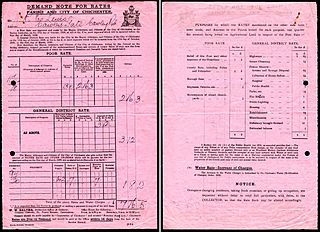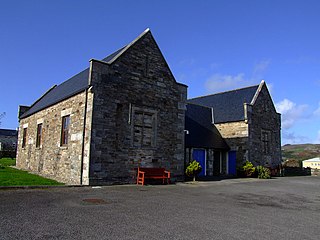Related Research Articles

The English Poor Laws were a system of poor relief in England and Wales that developed out of the codification of late-medieval and Tudor-era laws in 1587–1598. The system continued until the modern welfare state emerged after the Second World War.

In Britain and Ireland, a workhouse was an institution where those unable to support themselves financially were offered accommodation and employment. The earliest known use of the term workhouse is from 1631, in an account by the mayor of Abingdon reporting that "we have erected wthn [sic] our borough a workhouse to set poorer people to work".
The Charity Organisation Societies were founded in England in 1869 following the 'Goschen Minute' that sought to severely restrict outdoor relief distributed by the Poor Law Guardians. In the early 1870s a handful of local societies were formed with the intention of restricting the distribution of outdoor relief to the elderly.

The Poor Law Amendment Act 1834 (PLAA) known widely as the New Poor Law, was an Act of the Parliament of the United Kingdom passed by the Whig government of Earl Grey. It completely replaced earlier legislation based on the Poor Relief Act 1601 and attempted to fundamentally change the poverty relief system in England and Wales. It resulted from the 1832 Royal Commission into the Operation of the Poor Laws, which included Edwin Chadwick, John Bird Sumner and Nassau William Senior. Chadwick was dissatisfied with the law that resulted from his report. The Act was passed two years after the Representation of the People Act 1832 which extended the franchise to middle-class men. Some historians have argued that this was a major factor in the PLAA being passed.
The Roundsman System, in the Elizabethan Poor Law (1601), was a form of organised labour exchange for the poorest labourers by which a parish vestry helped to pay local farmers, households and others to employ such applicants for relief at a rate of headline wages negotiated and set by the parish. It depended not on the services, but on the wants of the applicants: the employers being repaid out of the poor rate all they advanced in wages beyond a very low-wage amount. Variants of the Roundsman system operated and co-existed from parish-to-parish and sometimes depending on type of labour.

The Book of Murder, also known as the Marcus Affair, was a piece of propaganda written in the 1830s in opposition to the English Poor Laws. It was presented as the work of one pseudonymous "Marcus", and was published by Joshua Hobson. It aimed to incite opposition to the Poor Law Amendment Act 1834, which had altered the nature of poor relief in England and Wales. Previously, paupers were eligible for "outdoor relief" ; this shifted to "indoor relief", meaning that workhouses were built, institutions to provide shelter and basic sustenance.

The Poor Relief Act 1601 was an Act of the Parliament of England. The Act for the Relief of the Poor 1601, popularly known as the Elizabethan Poor Law, "43rd Elizabeth" or the Old Poor Law was passed in 1601 and created a poor law system for England and Wales.
An overseer of the poor was an official who administered poor relief such as money, food, and clothing in England and various other countries which derived their law from England such as the United States.

In English and British history, poor relief refers to government and ecclesiastical action to relieve poverty. Over the centuries, various authorities have needed to decide whose poverty deserves relief and also who should bear the cost of helping the poor. Alongside ever-changing attitudes towards poverty, many methods have been attempted to answer these questions. Since the early 16th century legislation on poverty enacted by the English Parliament, poor relief has developed from being little more than a systematic means of punishment into a complex system of government-funded support and protection, especially following the creation in the 1940s of the welfare state. Poor relief will control crime if adequately given.

In England and Wales the poor rate was a tax on property levied in each parish, which was used to provide poor relief. It was collected under both the Old Poor Law and the New Poor Law. It was absorbed into 'general rate' local taxation in the 1920s, and has continuity with the currently existing Council Tax.

The house of correction was a type of establishment built after the passing of the Elizabethan Poor Law (1601), places where those who were "unwilling to work", including vagrants and beggars, were set to work. The building of houses of correction came after the passing of an amendment to the Elizabethan Poor Law. However the houses of correction were not considered a part of the Elizabethan Poor Law system because the Act distinguished between settled poor and wandering poor.

The Act for the Relief of the Poor 1597 was a piece of poor law legislation in England and Wales. It provided the first complete code of poor relief and was later amended by the Poor Relief Act 1601, which formed the basis of poor relief for the next two centuries.

The Irish Poor Laws were a series of Acts of Parliament intended to address social instability due to widespread and persistent poverty in Ireland. While some legislation had been introduced by the pre-Union Parliament of Ireland prior to the Act of Union, the most radical and comprehensive attempt was the Irish act of 1838, closely modelled on the English Poor Law of 1834. In England, this replaced Elizabethan era legislation which had no equivalent in Ireland.
The Scottish Poor Laws were the statutes concerning poor relief passed in Scotland between 1579 and 1929. Scotland had a different Poor Law system to England and the workings of the Scottish laws differed greatly to the Poor Law Amendment Act which applied in England and Wales.
The Historiography of the Poor Laws can be said to have passed through three distinct phases. Early historiography was concerned with the deficiencies of the Old Poor Law system, later work can be characterized as an early attempt at revisionism before the writings of Mark Blaug present a truly revisionist analysis of the Poor Law system.
Poor Law policy after the New Poor Law concerns the time period c. 1847–1900 after the implementation of the Poor Law Amendment Act until the beginnings of the decline of the Poor Law system at the start of the 20th century.
The following article presents a Timeline of the Poor Law system from its origins in the Tudor and Elizabethan era to its abolition in 1948.
The Tudor Poor Laws were the laws regarding poor relief in the Kingdom of England around the time of the Tudor period (1485–1603). The Tudor Poor Laws ended with the passing of the Elizabethan Poor Law in 1601, two years before the end of the Tudor dynasty, a piece of legislation which codified the previous Tudor legislation.

The Relief of the Poor Act 1696, formally titled An Act for supplying some Defects in the Laws for the Relief of the Poor of this Kingdom, was a 1697 welfare statute, operating within the framework of the Act for the Relief of the Poor 1601, also called the Elizabethan Poor Act. This Act is perhaps best remembered for its expansion of the requirement that welfare recipients be marked to indicate their status, in this case by wearing a prominent badge.

The 10th Parliament of Queen Elizabeth I was summoned by Queen Elizabeth I of England on 11 September 1601 and assembled on 27 October 1601. It was to be her final Parliament.
References
- ↑ The 1601 Elizabethan Poor Law
- ↑ "Outdoor relief" Oxford Reference (Accessed 18 July 2020)
